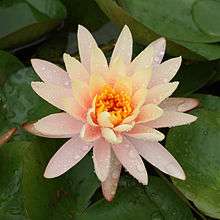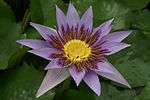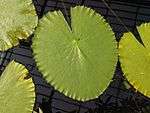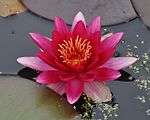Nymphaea
| Nymphaea | |
|---|---|
 | |
| Nymphaea 'Peach Glow' | |
| Scientific classification | |
| Kingdom: | Plantae |
| Clade: | Angiosperms |
| Order: | Nymphaeales |
| Family: | Nymphaeaceae |
| Genus: | Nymphaea L. |
| Species | |
|
About 36 species, see text[1] | |
Nymphaea /nɪmˈfiːə/ is a genus of hardy and tender aquatic plants in the family Nymphaeaceae. The genus has a cosmopolitan distribution. Many species are cultivated as ornamental plants, and many cultivars have been bred. Some taxa occur as introduced species where they are not native,[2] and some are weeds.[3] Plants of the genus are known commonly as water lilies.[2][4] The genus name is from the Greek νυμφαια, nymphaia and the Latin nymphaea, which mean "water lily" and were inspired by the nymphs of Greek and Latin mythology.[2]
Description
Water lilies are aquatic rhizomatous perennial herbs, sometimes with stolons, as well. The leaves grow from the rhizome on long petioles. Most of them float on the surface of the water. The blades have smooth or spine-toothed edges, and they can be rounded or pointed. The flowers rise out of the water or float on the surface, opening during the day or at night.[2] Many species of Nymphaea display protogynous flowering. The temporal separation of these female and male phases is physically reinforced by flower opening and closing, so the first flower opening displays female pistil and then closes at the end of the female phase, and reopens with male stamens.[5] Each has at least eight petals in shades of white, pink, blue, or yellow. Many stamens are at the center.[2] Water lily flowers are entomophilous, meaning they are pollinated by insects, often beetles.[2] The fruit is berry-like and borne on a curving or coiling peduncle.[2]
Cultivation
Water lilies are not only decorative, but also provide useful shade which helps reduce the growth of algae in ponds and lakes.[6] Many of the water lilies familiar in water gardening are hybrids and cultivars. These cultivars have gained the Royal Horticultural Society's Award of Garden Merit:
- 'Escarboucle'[7] (orange-red)
- 'Gladstoniana'[8] (double white flowers with prominent yellow stamens)
- 'Gonnère'[9] (double white scented flowers)
- 'James Brydon;'[10] (cupped rose-red flowers)
- 'Marliacea Chromatella'[11]' (pale yellow flowers)
- 'Pygmaea Helvola'[12] (cupped fragrant yellow flowers)
Other uses
Water lilies have several edible parts. The young leaves and unopened flower buds can be boiled and served as a vegetable. The seeds, high in starch, protein, and oil, may be popped, parched, or ground into flour. Potato-like tubers can be collected from the species N. tuberosa.[13]
Taxonomy
This is one of several genera of plants known commonly as lotuses. It is not related to the legume genus Lotus or the Chinese and Indian lotuses of genus Nelumbo. It is closely related to Nuphar lotuses, however. In Nymphaea, the petals are much larger than the sepals, whereas in Nuphar, the petals are much smaller. The process of fruit maturation also differs, with Nymphaea fruit sinking below the water level immediately after the flower closes, and Nuphar fruit remaining above the surface.
Subdivisions of genus Nymphaea:[14]
- Subgenus:
- Anecphya
- Brachyceras
- Hydrocallis
- Lotos
- Nymphaea:
- section Chamaenymphaea
- section Nymphaea
- section Xanthantha
| Name – common name |
|---|
|
Cultural significance

The ancient Egyptians revered the Nile water lilies, which were known as lotuses. The lotus motif is a frequent feature of temple column architecture.
The flowers of the blue Egyptian water lily (N. caerulea) open in the morning and then sink beneath the water at dusk, while those of the white water lily (N. lotus) open at night and close in the morning. Egyptians found this symbolic of the separation of deities and of death and the afterlife. Remains of both flowers have been found in the burial tomb of Ramesses II.
A Roman belief existed that drinking a liquid of crushed Nymphaea in vinegar for 10 consecutive days turned a boy into a eunuch.
A Syrian terra-cotta plaque from the 14th-13th centuries BC shows the goddess Asherah holding two lotus blossoms. An ivory panel from the 9th-8th centuries BC shows the god Horus seated on a lotus blossom, flanked by two cherubs.[15]
The French Impressionist painter Claude Monet is known for his many paintings of water lilies in the pond in his garden at Giverny.[16]
N. nouchali is the national flower of Bangladesh[17] and Sri Lanka.[18]
Water lilies are also used as ritual narcotics. This topic "was the subject of a lecture by William Emboden given at Nash Hall of the Harvard Botanical Museum on the morning of April 6, 1979".[19]
Examples



 Nymphaea 'Attraction'
Nymphaea 'Attraction' Nymphaea laydekeri purpurata
Nymphaea laydekeri purpurata_1200.jpg)
_1200.jpg)
_1200.jpg)
References
- ↑ Nymphaea. The Plant List.
- 1 2 3 4 5 6 7 Nymphaea. Flora of North America.
- ↑ Nymphaea. The Jepson eFlora 2013.
- ↑ Nymphaea. Integrated Taxonomic Information System (ITIS).
- ↑ Povilus, R. A.; Losada, J. M.; Friedman, W. E. (2015). "Floral biology and ovule and seed ontogeny of Nymphaea thermarum, a water lily at the brink of extinction with potential as a model system for basal angiosperms". Annals of Botany. 115: 211–226. doi:10.1093/aob/mcu235.
- ↑ RHS A-Z Encyclopedia of Garden Plants. United Kingdom: Dorling Kindersley. 2008. p. 1136. ISBN 1405332964.
- ↑ "RHS Plant Selector - Nymphaea 'Escarboucle'". Retrieved 25 May 2013.
- ↑ "RHS Plant Selector - Nymphaea 'Gladstoniana'". Retrieved 25 May 2013.
- ↑ "RHS Plant Selector - Nymphaea 'Gonnere'". Retrieved 25 May 2013.
- ↑ "RHS Plant Selector - Nymphaea 'James Brydon'". Retrieved 25 May 2013.
- ↑ "RHS Plant Selector - Nymphaea 'Marliacea Chromatella'". Retrieved 25 May 2013.
- ↑ "RHS Plant Selector - Nymphaea 'Pygmaea Helvola'". Retrieved 25 May 2013.
- ↑ Peterson, L. A. (1977). A Field Guide to the Wild Edible Plants of Eastern and Central North America. New York, New York: Houghton Mifflin. p. 22.
- ↑ "USDA GRIN Taxonomy".
|chapter=ignored (help) - ↑ Dever, W. G. Did God have a Wife? Archeology and Folk Religion in Ancient Israel. Wm. B. Eerdmans Publishing Co. 2008. pp 221, 279.
- ↑ "Water Lilies: Claude Monet (French, 1840–1926)". Heilbrunn Timeline of Art History. Metropolitan Museum of Art. December 2008. Retrieved 8 March 2015.
- ↑ "Bangladesh Constitution".
|chapter=ignored (help) - ↑ Jayasuriya, M. Our national flower may soon be a thing of the past. The Sunday Times April 17, 2011.
- ↑ "The Ethno-Pharmacology Society Newletter". 2 (4). Spring 1979.
External links
| Wikimedia Commons has media related to Nymphaea. |
Further reading
- Slocum, P. D. Waterlilies and Lotuses. Timber Press. 2005. ISBN 0-88192-684-1 (restricted online version at Google Books)
_1200.jpg)